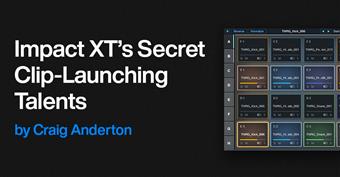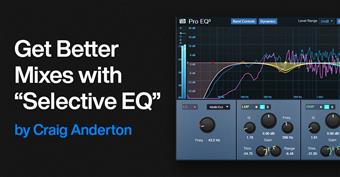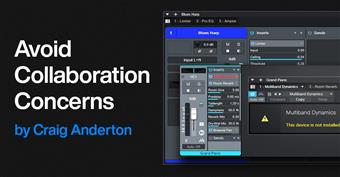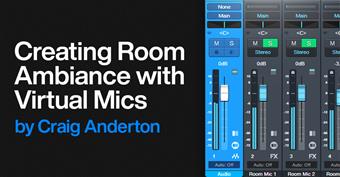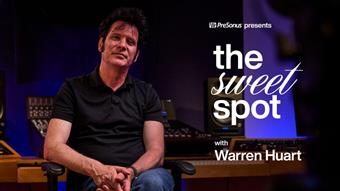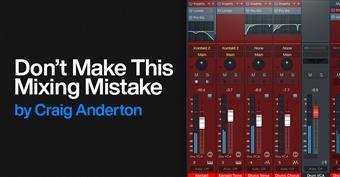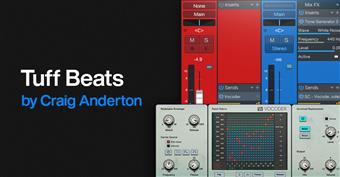
Lately, it seems there's an increasing buzz about LCR mixing. LCR stands for Left, Center, and Right, and it's a panning technique where all panpots are set to either left, center, or right-nothing in between. Look it up on the internet, and you'll find polarized opinions that vary from it's the Holy Grail of mixing, to it's ridiculous and vaguely idiotic. Well, I'm not polarized, so I'll give you the bottom line: it can work well in some situations, but not so well in others.
Proponents of this style of mixing claim several advantages:
The resulting mixes sound very wide without having to use image processing, because there's so much energy in the sides.
It simplifies mixing decisions, because you don't have to agonize over stereo placement.
Mixes translate well for those not sitting in stereo's sweet spot, because the most important material is panned to the center.
It forces you to pay attention to EQ and the arrangement, to make sure there's good differentiation among instruments panned hard left and hard right.
If an LCR mix leaves holes in the stereo field, then you can use reverb or other stereo ambience to fill that space. As one example, stereo overhead mics on drums can pan hard left and hard right, yet still fill in a lot of the space in the middle. Or, place reverb in the channel opposite of where a signal is panned.
There are plenty of engineers who prefer LCR mixes for the reasons given above. However, LCR is not a panacea, nor is it necessarily desirable. It also may not fit an artist's goal. For those who think of music in more symphonic terms-as multiple elements creating a greater whole, to be listened to under optimal conditions-the idea of doing something like panning the woodwinds and brass far left and the violins full right, with orchestral percussion and double bass in the middle, makes no sense. Conversely, if you're doing a pop mix where you want every element to be distinct, an LCR approach can work well, if done properly.
Then again, some engineers consider a mix to be essentially a variation on mono, because the most important elements are panned to center. They don't want distractions on the left and right; those elements exist to provide a frame around the center.
Another consideration is according to all the stats I've seen, these days more people listen on headphones than component system speakers. LCR mixing can sound great at first on headphones due to the novelty, but eventually becomes unnatural and fatiguing. Then again, as depressing a thought as this may be, a disturbingly large part of the population listens to music on computer speakers. Any panning nuances are lost under those conditions, whereas LCR mixing can sound direct and unambiguous.
Help Is on the Way!
So what's a mix engineer to do? Well, a good way to get familiar with LCR is to load up some of your favorite songs into Studio One, and listen to the mid and sides separately. Hearing instruments in the sides tends to imply an LCR mix; Madonna's Ray of Light comes to mind. For a pure LCR mix, listen to the original version of Cat Stevens' Matthew and Son on YouTube. It was recorded in 1966 (trivia fans: John Paul Jones, later of Led Zeppelin, played bass). Back then, the limited number of tracks, and mixing console limitations, almost forced engineers into doing LCR. In case you wondered why some songs of that era had the drums in one channel and the bass in the opposite channel now you know why.
Anyway, it's easy to do mid-side analysis in Studio One (Fig. 1).
Figure 1: Setup for analyzing mid and side components of music.
The Mixtool, with MS Transform selected, encodes a stereo signal into mid (left channel) and sides (right channel). However, it's difficult to do any meaningful analysis with the mid in one ear and the sides in the other. So, the Dual Pan's Input Balance control chooses either the mid
or sides . The panpots place the chosen audio in the center of the stereo field.
Once you start finding out whether your favorite songs are LCR or mixed more conventionally, it will help you decide what might work best for you. If you decide to experiment with LCR mixing, bear in mind that it kind of lives by its own rules, and it takes some experience to wrap your head around how to get the most out of it.
And the Verdict Is
Well, you can believe whatever you like from what you see on the internet, and more importantly, choose what sounds best to you but this is my blog post, so here's what I think . Any and all comments are welcome!
As mentioned in a previous blog post, I always start mixes in mono. I feel this is the best way to find out if sounds mask either other, whether some tracks are redundant because they don't contribute that much to the arrangement, and which tracks need EQ so they can carve out their own part of the frequency spectrum. That way, whether instruments are on top of each other or spread out, they'll work well together.
But from there on, I split my approach. I still favor the center and use the sides as a frame, but also selectively choose particular elements (usually rhythm guitar, keyboards, and percussion) to pan off to the left or right so there's a strong presence in the sides. For me, this gives the best of both worlds: a wide mix with good separation of various elements, but done in service of creating a full mix, without holes in the stereo field. Those who listen on headphones won't be subjected to an over-exaggerated stereo effect, while those who listen over speakers will have a less critical sweet spot than if there was nuanced panning.
I came up with this approach simply because it fits the kind of music I make, and the way I expect most people will listen to it. Only later did I find out I had combined L
More from PreSonus
19/04/2024
By Craig Anderton
Impact XT can launch clips, which is great for songwriting (see the blog post Songwriting with Impact XT). But few people realize that Impact...
12/04/2024
By Craig Anderton
Good mixes often depend on carving out a unique sonic space for each instrument, so you can hear them clearly. Sometimes carving out that spa...
05/04/2024
By Craig Anderton
MIDI guitars are a niche product, because the learning curve can be daunting for some guitar players. However, I'm surprised how many pro...
29/03/2024
By Craig Anderton
As the universe of Studio One users grows, so do opportunities for collaboration. But your collaborator may not be using the same version of ...
22/03/2024
By Craig Anderton
Over three years ago, I wrote a blog post on how to make a drumcoder. Its design was somewhat like a vocoder-drum audio served as a modulat...
15/03/2024
By Craig Anderton
One of Atmos's coolest features is scalability. No matter how complex your Atmos project may be, you can render it as Binaural, 5.1, 5.1....
13/03/2024
Watch the Brooklyn Synthpop duo remix their song Blame in Studio One
Less than 24 hours after meeting each other, producer Luke Moellman and vocalist Jon San...
10/03/2024
By Craig Anderton
The impetus behind this design was wanting to add envelope flanging to amp sims like Ampire. But there's a problem: most amp sim outputs ...
01/03/2024
By Craig Anderton
Supplementing close-miking techniques with room mics gives acoustic sounds a life-like sense of space. Typically, this technique involves pla...
27/02/2024
Notion Mobile v3 took mobile music creation to the next level with support for iOS, Android, Windows, Fire OS and macOS. Now v3.3 adds many enhancements and fix...
26/02/2024
Logic's Grammy-nominated producer breaks down his Sweet Spot.
Before he found success as an avant-garde hip hop producer, 6ix was just 30 units shy of a de...
25/02/2024
The Grammy-nominated multi-Platinum producer breaks down his Sweet Spot.
From the studio with chart-topping artists like Aerosmith and The Fray, to empowering ...
23/02/2024
By Craig Anderton
Do you think of mixes in absolute terms, or relative terms? Knowing the difference, and when to apply which approach, can make a huge differe...
16/02/2024
By Craig Anderton
Calling all beats/hip-hop/EDM/hard rock fans: This novel effects starts with drums modulating the Vocoder's white noise carrier, and take...
09/02/2024
This tip is about working with stereo, NOT about Dolby Atmos or surround-but we're going to steal some of what Atmos does to reinvent stereo panning. Stud...
07/02/2024
The GRAMMY-winning recording and mix engineer shows us how he uses Studio One to create an artful immersive mix.
Jeff Ellis is a force to be reckoned with. The...
02/02/2024
Presence's sound library includes a fine acoustic 12-string guitar, but not an electric one. So, perhaps it's not surprising that one of the more popula...
26/01/2024
At first, this might not seem too exciting. But follow the directions below, and try comping using this method-I don't think you'll be disappointed. Thi...
19/01/2024
You know the feeling: You're tracking or doing an overdub with a virtual instrument or amp sim, but you're frustrated by the excessive latency inherent ...
12/01/2024
Recording audio using more than one feed from the same source may create phase issues. For example, when miking a bass amp and taking a DI (dry) input, the DI&#...
05/01/2024
If you haven't experimented yet with mid-side stereo miking, you'll be in for a treat when you do. Here's why:
Record background singers with gorge...
29/12/2023
This complements the tip Better Ducking for Voiceovers and Podcasts and the tip Why I Don't Use Compression Anymore. It applies the concept of voiceover duc...
22/12/2023
Engineers sometimes advocate using high-pass filters to clean up the low end and tighten the sound. Others believe that because of issues inherent in highpass...
20/12/2023
The GRAMMY-nominated artist, producer, and songwriter shows us how he uses Studio One to cook a musical idea from scratch.
Josh Cumbee is a triple threat: The ...
15/12/2023
This wasn't a conscious decision, or something I planned. But when I looked through my last few songs while seeking candidates for a book's screenshots,...
08/12/2023
First, a follow-up: In the October 13 tip about creating Track Presets for parallel processing, I mentioned that Track Presets can't include buses, which is...
01/12/2023
Vocoder's aren't normal effects. For example, Arturia's Vocoder V is an effect/instrument hybrid, because it's an audio effect that includes a...
24/11/2023
For over a decade, stereo and mono vinyl records co-existed before the transition to stereo was complete. During that time, many records were released in both m...
17/11/2023
Strings can enhance almost any genre of music-and with a little more effort, you can do string arrangements that go beyond simply adding a string pad preset. So...
10/11/2023
Since Dynamic EQ was introduced in version 5, I've used it to replace and improve some techniques I used to do with static EQ. For example, I'm a fan of...
03/11/2023
Gregor Beyerle recently posted a video called Producer vs. Engineer-What's the Difference?, which had quite a few comments. It seems most people feel that f...
27/10/2023
Sending too many low frequencies through reverb gives a bloated, muddy sound. This is one reason why you'll rarely see a send from a bass track going into r...
20/10/2023
While trying to do something else with Melodyne, I stumbled on this way to add depth or tightness to drum sounds-quickly and easily. Here's the sound of an ...
13/10/2023
Parallel processing splits a signal into two or more parallel channels. Bi-amping is a common example of parallel processing:
One channel processes low frequen...
06/10/2023
Everyone talks about the importance of Dolby Atmos for post-production, but the implications go further than that. Atmos really does change how you create and ...
29/09/2023
You don't need a massive surround system with speakers wired all over your studio to create immersive audio. Whether you want surround or Dolby Atmos mixes...
22/09/2023
By Craig Anderton
Background music or environmental sounds are usually an essential part of commercials, movies, presentations, podcasts, and more. When doing ...
15/09/2023
The post Mixing la Studio One had a great response, so here's another tip that relates more to making better music than making better-sounding music. We&#...
08/09/2023
This FX Chain's inspiration is the Tilt filter circuit created by Tonelux designer Paul Wolff. First used in the Tonelux MP1A mic preamp, the Tilt filter h...
01/09/2023
But first, some breaking news: Version 1.5 of The Huge Book of Studio One Tips and Tricks is now available from the PreSonus shop. Like previous versions, it�...
25/08/2023
Studio One 6.2 reworked Layer and Take handling, and some of the new functionality is exceptionally useful. For example, suppose you want to record comp vocals ...
18/08/2023
We haven't done a boutique digital effect for Studio One Professional in a while, so let's use a plugin in a totally wrong way-yet end up with somethi...
11/08/2023
MIDI drum loops have a bad rap, because some musicians consider them metronomic and boring. But they don't have to be. Subtly leading or lagging the beat at...
04/08/2023
Ask 100 recording engineers about their approach to mixing, and you'll hear 100 different answers. Here's mine, and how this approach relates to Studio ...
28/07/2023
FL Studio is a cool program. Yet when some users see me working with Studio One's features like comping tools, harmonic editing, the lyrics track, Mix FX, M...
21/07/2023
Bass has a tough gig. Speakers have a hard time reproducing such low frequencies. Also, the ear is less sensitive to low (and high) frequencies compared to midr...
18/07/2023
Notion Mobile v3 took mobile music creation to the next level with support for iOS, Android, Windows and macOS. Now v3.2 adds many enhancements and fixes, as we...
14/07/2023
First, an announcement: If you own the eBook How to Record and Mix Great Vocals in Studio One, you can download the 2.1 update for free from your PreSonus acc...
07/07/2023
Let's transform your acoustic piano instrument sounds-with effects that showcase the power of Multiband Dynamics. Choose from two download links at the end ...
24/06/2023
Acoustic drum loops freeze-dry a drummer's playing-so, what you hear is what you get. What you get. What you get. What you get. What you get. What you get.
...
 Lately, it seems there's an increasing buzz about LCR mixing. LCR stands for Left, Center, and Right, and it's a panning technique where all panpots are set to either left, center, or right-nothing in between. Look it up on the internet, and you'll find polarized opinions that vary from it's the Holy Grail of mixing, to it's ridiculous and vaguely idiotic. Well, I'm not polarized, so I'll give you the bottom line: it can work well in some situations, but not so well in others.
Lately, it seems there's an increasing buzz about LCR mixing. LCR stands for Left, Center, and Right, and it's a panning technique where all panpots are set to either left, center, or right-nothing in between. Look it up on the internet, and you'll find polarized opinions that vary from it's the Holy Grail of mixing, to it's ridiculous and vaguely idiotic. Well, I'm not polarized, so I'll give you the bottom line: it can work well in some situations, but not so well in others.













